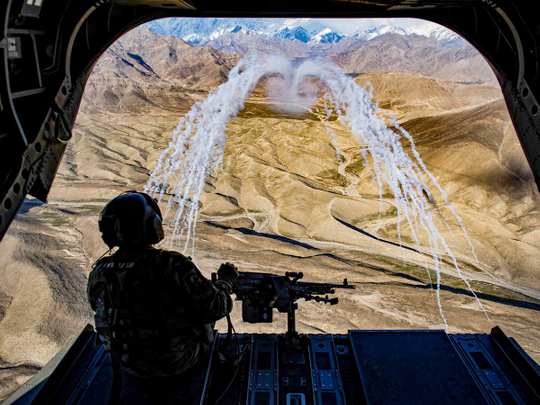
Washington, D.C.: US President Donald Trump will upend his own strategy to bring peace to Afghanistan and end America’s longest war if he proceeds with plans to withdraw about half of the 14,000 US troops there, according to veteran diplomats and US officials.
A drawdown also will deal a fresh blow to allies’ trust in the United States and give new room to militant groups Al Qaida and Daesh in which to operate and plot attacks, they said.
“Barring some unforeseen details that have yet to come out, there is no way I can objectively look at this and see this as beneficial,” said Jason Campbell, who was the Afghanistan country director at the Pentagon until September.
US officials said Trump has issued verbal orders to plan for a drawdown of close to 7,000 US troops.
But, they cautioned, he could always reverse course.
The White House and the Pentagon have not yet commented publicly.
Word of Trump’s decision followed a two-day meeting in Abu Dhabi earlier this week between US special peace envoy Zalmay Khalilzad and Taliban representatives at which the sides discussed a withdrawal of international forces and a ceasefire in 2019.
If a US drawdown goes ahead, “We just gave them half of what they wanted in all of this. Their top priority is for the United States to leave Afghanistan,” said Campbell, now an analyst with the RAND Corp think tank.
Trump unveiled a South Asia strategy in August 2017 calling for an open-ended deployment of US forces with the goal of compelling the Taliban to negotiate peace with the Kabul government.
But with the insurgents controlling large swaths of territory and chronically understrength Afghan forces suffering thousands of casualties a month, even a partial US withdrawal reduces pressure on the Taliban to strike a deal, the experts and officials said. It also threatens to erode Afghan troops’ willingness to fight.
Richard Olson, a former US special envoy to Afghanistan and Pakistan, said that Trump’s plan severely weakened Khalilzad’s negotiating hand.
“It’s easier for them (the Taliban) to envision waiting us out,” he said.
Military fight
Late last year, Trump reluctantly agreed to deploying thousands of additional US troops.
The United States has about 14,000 troops in Afghanistan as part of a NATO-led mission, known as Resolute Support, and a US counter-terrorism mission largely directed against groups such as Daesh and Al Qaida.
Some 8,000 troops from 38 other countries are participating in Resolute Support.
The planned drawdown, according to a Pentagon adviser who spoke on the condition of anonymity, blindsided top US military and allied commanders.
US commanders now will have to scramble to rebalance the international forces remaining in Afghanistan between training and advising Afghan security forces and fighting Al Qaida and Daesh’s South Asian branch, according to Ronald Neumann, a former US ambassador to Kabul.
Thursday’s news of the planned drawdown followed Trump’s order on Wednesday to withdraw all 2,000 US troops from Syria.
Trump said Daesh had been defeated and there was no longer a need for US forces in Syria.
“The Syrian and the Afghan withdrawals together mark the United States as a power too large to ignore and too fickle to trust,” said Neumann.
The departure of Defence Secretary Jim Mattis, who announced his resignation on Thursday over policy differences with Trump, could also affect coordination with allies.
Mattis twice drafted letters over the past two years asking Nato allies to increase or maintain their troop levels and many countries agreed, said Campbell, the former Pentagon official.
“He was very influential and personally involved in doing that,” Campbell said.
A US official, speaking on the condition of anonymity, said the military has begun planning the details of a drawdown, which could include reviewing what bases the United States would keep and what type of troops would be removed.
The official acknowledged it would be difficult to maintain the same military missions with half the troops.












